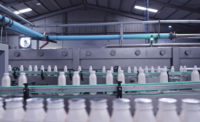Limited shelf life has long been a challenge for many refrigerated food and beverage segments, and the dairy sector is no exception. But extended shelf life (ESL) and aseptic processing are helping a number of dairy processors overcome that challenge — and potentially expand distribution geographically at the same time.
A lot to consider
But obstacles remain when it comes to processor acceptance and implementation of ESL and aseptic technologies. Cost, for example, is an issue. As JeanPierre Berlan, vice president of processing – liquid food for Tetra Pak U.S. and Canada, explained, processors face conversion-related investments tied to technology and infrastructure to support the equipment.
But the investment might be worth it.
“Higher processing costs are often balanced with the fact that longer shelf life is typically used for value-added products that drive a premium price,” Berlan said. “However, for products such as white milk, it is not always possible to extract a premium price. In this case, it becomes important to adopt technologies that provide some options to extend shelf life that are more cost-effective than a high-heat treatment.”
The use of hydrogen peroxide to disinfect aseptic packaging also is a concern for many processors, noted Jean Dion, vice president of business development for Geosaf, Montreal.
“Not all plants are equipped for — or have the technology to follow through with — that,” he said. “The best way to [resolve that issue] is to deal with companies that offer a turnkey solution,” he added, noting that his company has lent its expertise in this area for more than 25 years.
Speaking of hydrogen peroxide, FDA limits its residual to 0.5 parts per million, according to Midland, Va.-based CHEMetrics. And residual hydrogen peroxide can detrimentally impact a product’s quality and nutritional value.
So processors need to take appropriate measures to remove residual peroxide from finished products. To ensure they’ve done so, CHEMetrics offers hydrogen peroxide self-filling ampoules and hydrogen peroxide test strips that deliver accurate and repeatable results in routine peroxide residual monitoring for both aseptic and ESL applications.
Yet another challenge is that ESL processing requires a balance between the bacteria spore kill rate and chemical changes to the product, said Allan Hurup Vangsgaard, global product manager, systems for SPX Flow, Charlotte, N.C.
“Increasing time and temperature of sterilization processes gives higher kill rates and longer shelf life, but equally more chemical changes in the product, which affects premium characteristics,” he noted. “The right processing technique and parameters will vary, depending on product type and the features required in the end product, but having the correct control in place is vital.”
He encourages processers to also consider the cold chain when balancing shelf life and premium product characteristics. For example, products destined for an area with a strong established cold chain can be ensured of distribution at a lower temperatures (5 degrees Celsius), but products destined for emerging markets often need to be developed for storage at a higher temperature (10 degrees Celsius).
“Alongside creating a final product with optimized characteristics and shelf life, the biggest challenge dairy processors face is how to achieve this competitively,” Vangsgaard added. “Value can be added to the product line with improved heat recovery, optimized use of materials and other utilities, and increased runtimes. Reducing the frequency of cleaning cycles and time to clean increases production efficiency and reduces overall running costs.”
On the aseptic side, processors face risks, too, so risk management is an important tool for evaluating new packaging and products, said Sam Troiano, product manager for PTI-Waldner North America, Tuckahoe, N.Y.
“Go through this process to mitigate risks,” he advised. “There are operational risks and consumer risks, which can be the beginning of the end for a company.”
Processors also must understand that packaging machines can preserve only the microbiological state of the product they receive, added Richard J. Szyperski, technical product manager for Evergreen Packaging Equipment, Cedar Rapids, Iowa. Such machines cannot improve the quality or shelf life of the packaged product.
Consider R&D, too
Challenges also can be found on the R&D side of ESL and aseptic processing. Some processors attempt to use full-scale production equipment or “pilot plant” equipment for R&D here, but both bring with them major issues such as considerable expense and a longer development cycle, said David Miles, executive vice president for MicroThermics Inc., Raleigh, N.C.
“The use of properly designed R&D processors avoids or resolves these problems,” he noted. “While we build small-scale thermal processing equipment, our primary business in R&D is the actual process simulation. If an R&D processor does not have the right heating and cooling curves, in addition to the right hold times, then it will not enable you to scale up to the plant or down to the lab.”
MicroThermics builds its equipment in two ways, he added. The first uses the company’s standard designs, which already take into account the heating and cooling rates typically found commercially, and customizes them for processors’ specific needs. The second involves a custom design based on a processor’s actual time and temperature history.
Ready to help
The good news is that suppliers of ESL and aseptic processing equipment continue to introduce updates and innovations with dairy processors’ challenges in mind.
Berlan noted that during the past three years, Tetra Pak has introduced technologies such as bactofugation and microfiltration for preserving white milk.
“These technologies, coupled with enhanced levels of plant hygiene and strict control of temperatures throughout the distribution process, have created new opportunities for white milk,” he said. “It is now possible to expect a longer pasteurized white milk shelf life, of 25 to 40 days, with limited added processing costs.”
For its part, Bosch Packaging Technology recently debuted the Ampack FCL, an aseptic inline filling machine for preformed cups that enhances product safety, flexibility, efficiency and ease of use, said Rich Mueller, vice president of sales for Oldsmar, Fla.-based Osgood Industries Inc., part of Bosch Packaging Technology.
“It features a smaller aseptic chamber to improve product control, thus minimizing the risk of food contamination,” he said. “Additionally, the machine chain is kept outside of the aseptic chamber, limiting bacterial buildup and maintenance needs.”
The eight-lane linear filler — available in ultra-clean or aseptic executions — also can handle two cup formats ranging from 75 millimeters to 95 millimeters in diameter, at speeds as high as 20,000 cups per hour, Mueller explained. It fills a broad range of products having particles up to 25 millimeters in diameter.
“It is an ideal solution for products requiring a longer shelf life outside the cooling chain — from four to six weeks or up to 12 months, the highest level available on the market,” he added. “An additional benefit of short delivery times stems from its modular and standardized design, including the new HMI 4.0, a true gateway to the connected factory.”
And Evergreen Packaging’s newest machine introductions boast more servo-driven functions that automatically control fill volumes and profiles according to product and carton size, Szyperski noted. The result is quicker, consistent changeover that’s less dependent on the operator.
“This provides flexibility and repeatable package performance to maximize machine efficiency,” he said. “Infinite fill adjustments allow for less downtime, with quick and easy changes to fill volume and carton height. The servo-driven fill system allows for improved fill accuracy, resulting in potential savings to the processor.”
And Evergreen Packaging’s ELL (Extended Long Life ) gable-top fillers boast proprietary features that maximize the shelf life of not only milk, but also specialty milk products, plant-based beverages and still beverages, Szyperski added.
“A self-contained CIP/SIP (clean-in-place/sterilize-in-place) system, environmental control features, carton decontamination and hermetic filling system maintain product quality and preserve freshness,” he said.
Troiano said PTI-Waldner North America now offers an ESL filling and sealing machine featuring cup and lid sterilization for products to provide a 40-day shelf life across the refrigerated supply chain.
“This is a high-performance machine for high-quality fresh dairy products meant to be consumed and enjoyed shortly after production,” he said.
Although Waldner machines are not true “aseptic” units, they meet the criteria for most dairy products, Troiano noted. And they can be equipped with a laminar flow hood and filters needed to create a clean air environment to meet the specific requirements for yogurt, cream or cottage cheese.
“Often customers are under the impression they need a fully aseptic rated machine for their product when, in effect, they have to meet a certain log reduction, a number or mathematical terms that will show the relative number of live microbes eliminated from the surface by disinfecting or cleaning,” he added.
New from MicroThermics, meanwhile, are an aseptic laboratory filler and continuous flow microwave processing that uses Aseptiwave technologies, Miles said.
“Our filler enables companies to fill into plastic bottles that have been sterilized with a 5-log reduction of bacteria in a sterile environment, on a continuous basis, just like a commercial filler,” he explained. “Our microwave processors can process products with no heated surfaces, resulting in the freshest-tasting aseptic and ESL products.”
And SPX Flow is committed to continuing research and development for dairy processing solutions, Vangsgaard noted.
“These include ongoing drives to increase heat recovery and processing efficiency,” he said. “This means that established technologies, including UHT systems, are frequently being modified and enhanced based on new ideas, new technology or just ongoing experience.”
The company also is adjusting pipe design and flow patterns to decrease fouling and product buildup in lines, reducing cleaning time and extending runtimes between cleaning cycles, Vangsgaard noted.
As for Geosaf, it works in cooperation with the supplier of the aseptic process and the aseptic packaging solution, Dion said, to provide a comprehensive solution.
“We have the knowledge to come up with a solution [for] each package size, each UPC code,” he said.






